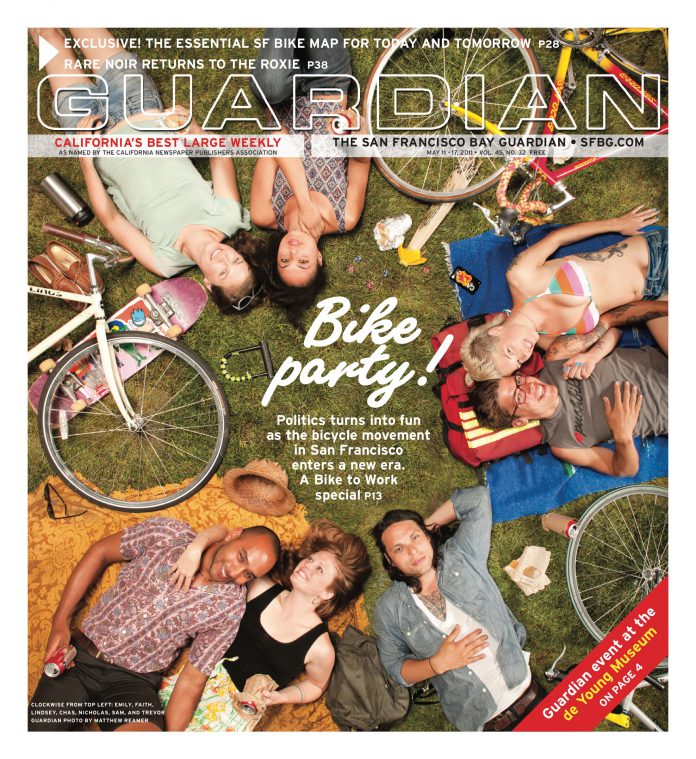news@sfbg.com
To meet San Francisco’s policy goal of having 20 percent of all vehicle trips made by bicycle by the year 2020, advocates and officials say the city will need to make cycling more attractive to the young and old, from age 8 to 80. But there are some built-in challenges to getting more school children on bikes, even if there has been some recent progress, as demonstrated during the Bike to School Day in April.
“I see more and more middle and high school teams out there,” Leah Shahum, executive director of the San Francisco Bicycle Coalition, said of the group rides to and from school that parents have been organizing.
According to a 2009 David Binder poll, seven out of 10 residents in San Francisco use a bicycle (this includes regular commuters and once-a-year riders) and last year’s city count of bike ridership from the San Francisco Municipal Transportation Agency’s annual report saw a 58 percent increase in the number of cyclists on the road. At any given time during regular business weekday hours, some 9,210 riders pedal through the streets, according to last year’s results.
Children account for some of that increase, as demonstrated by the Bike to School Day event and its 3,000 riders — the most ever. Shahum attributes some of the increase to the new separated bikeways on Market Street, Alemany Boulevard, and Laguna Honda Boulevard, which allow children and their parents to feel safer. “When the bikeway was introduced, the numbers increased — there is growing demand.”
Programs like the Department of Public Health’s Safe Routes to School and SF Unified School District’s Student Support Services Department are helping to raise awareness of the improvements to encourage more cycling by young people.
Safe Routes to School Project Coordinator Ana Validzic said cycling is often more convenient than driving to school, particularly given the difficult parking situations at schools. Martha Adriasola, a committee member for the program, said parents and students also are attracted by the increased physical activity from cycling.
But a large portion of San Francisco’s grade school-bound population has yet to join the pedal revolution. Adriasola mentioned several reasons that prevent children from biking, including getting to schools on hills or far from home as well as the lack of bike storage at schools.
“There used to be a lot of concern about where to keep the bicycles,” Adriasola told the Guardian. But that’s changing thanks to a recent grant from the Department of Sustainability will provide bike racks for students at all schools in the district.
“That was one of the missing pieces,” Shahum said of the bike racks. “The district understands that it is good for the city for folks to ride their bikes.”
With new racks lining the campuses, the question remains whether there will be enough riders to fill them. Efforts to improve diversity in the school system and parent preferences for certain schools mean many kids travel across town to school.
Gentle Blythe, SFUSD’s executive director of public outreach and communications, said that last year the school board modified its school selection system to encourage more students to attend their local schools by resolving ties between applicants based on whether the applicant lives in the school’s attendance area. Currently, Blythe said, three out of every four applicants list a school that is not the one closest to their home as their first choice.
According to SFUSD’s 2010 fall enrollment maps, which show all the district’s elementary schools and compares them to the students’ residences, most of the 72 schools have as many students traveling from across the district as those living within a mile of the campus. Parker Elementary in North Beach is such an example, with an almost equal number living inside and outside the neighborhood, including some who live as far away as Visitacion Valley.
With such a long way to ride, it’s difficult for parents and those concerned with safety to feel comfortable allowing children to ride. But Shahum believes it’s still possible. SFBC’s Connecting the City project advocates for safe, cross-town bikeways throughout the city, which could draw more children onto the streets.
Shahum noted that bicycling increased dramatically even when there was a court injunction barring new bike projects. “Imagine the change we can expect when the changes do come,” she said.
She also said that events such as Sunday Streets, the monthly carfree streets events, are attracting families and encouraging them to start cycling together. So the answer to encouraging more youth cycling may be to make the streets safer and more inviting for everyone.
“We hope, through the Connecting the City vision, to see people riding on cross-town bikeways — for everyone from 8 to 80.” she said.

